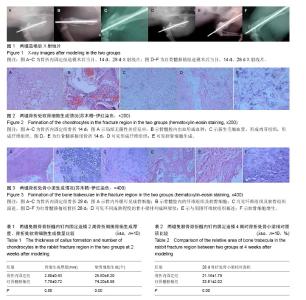| [1] 童培建,厉驹,瞿杭波,等.经皮自体骨髓间充质干细胞移植治疗四肢骨折骨不连[J].中华创伤杂志,2007,23(7):499-501.[2] 贺永祥,谢斌.金属植入物内固定治疗四肢骨折后的骨不连临床分析[J].吉林医学,2014,35(2):326-327. [3] 褚秀成,成帅,燕树义.干细胞移植修复骨折骨不连的效果评价[J].中国组织工程研究,2015,19(19):3112-3116.[4] 卢永.更换髓内钉和保留髓内钉、附加侧板治疗股骨干骨折髓内钉固定术后非感染性骨不连的疗效[J].中国医学工程,2015, 23(3):86-87.[5] 李曙光,王志文,袁强,等.可控性骨折模型早期内分泌改变的对照研究[J].第四军医大学学报,2005,26(16):1519.[6] Gallagher KA, Liu ZJ, Xiao M, et al. Diabetic impairments in NO-mediated endothelial progenitor cell mobilization and homing are reversed by hyperoxia and SDF-1 alpha. Clin Invest. 2007;117(5):1249-1259.[7] 殷俊辉,高悠水,张长青.骨髓干细胞治疗骨不连研究进展[J].国际骨科学杂志,2011,32(2): 111-112.[8] Kawaji H, Uematsu T, Oba R, et al.Treatment for Trochanteric Fracture of the Femur with Short Femoral Nail: A Comparison between the Asian Intramedullary Hip Screw (IMHS) and the Conventional IMHS.J Nippon Med Sch.2016;83 (3):113-117.[9] 沈强,黄诗博,朱建国.自体骨髓浓缩干细胞在治疗股骨干骨折中的应用[J].中国民康医学,2011,23(12):1460-1477.[10] Herberg S, Kondrikova G, Hussein KA,et al.Mesenchymal stem cell expression of stromal cell-derived factor-1β augments bone formation in a model of local regenerative therapy.J Orthop Res.2015;33(2):174-184.[11] Emara KM, Diab RA, Emara AK. Recent biological trends in management of fracture non-union.World J Orthop. 2015; 6(8):623-628. [12] Dimitriou R, Tsiridis E, Giannoudis PV. Current concepts of molecular aspects of bone healing. Injury. 2005;36(12): 1392-1404.[13] Tawonsawatruk T, Kelly M, Simpson H.Evaluation of native mesenchymal stem cells from bone marrow and local tissue in an atrophic nonunion model.Tissue Eng Part C Methods. 2014;20(6):524-532.[14] 邵擎东,李宇飞,许天明,等.自体红骨髓移植治疗鼠胫骨骨不连[J]. 中华实验外科杂志,2015,32(6):1375-1377.[15] 刘俊宾,亓向同.ECM修复兔桡骨缺损的实验研究[J].中国矫形外科杂志,2007,15(23):1818-1821.[16] Ozeki N, Jethanandani P, Nakamura H,et al. Modulation of satellite cell adhesion and motility following BMP2-induced differentiation to osteoblast lineage. Bio-chem Biophys Res Commun.2007; 353(1):54-59. [17] Tsuji K, Bandyopadhyay A, Harfe BD, et al. BMP2 activity, although dispensable for bone formation, is required for the initiation of fracture healing. Nat Genet. 2006;38(12): 1424-1429.[18] Xiong DH, Shen H, Zhao LJ, et al.Robust and comprehensive analysis of 20 osteoporosis candidategenes by very high-density single-nucleotide polymorphism screen among 405 white nuclear families identified significant associationand gene-gene interaction. J Bone Miner Res. 2006;21(11):1678-1695. [19] Edgar CM, Chakravarthy V, Barnes G, et al. Autogenous regulation of a network of bone morphogenetic proteins (BMPs) mediates the osteogenic differentiation in murine marrow stromal cells. Bone .2007;40(5):1389-1398.[20] Hewitt J, Lu X, Gilbert L, et al. The muscle transcri ption factor MyoD promotes osteoblast differentiation by stimulation of the Osterix promoter.Endocrinology. 2008; 149(7): 3698-3707.[21] Yu PJ, Ferrari G, G alloway AC, et al. Basic fibroblast growth factor(FGF-2): the highmolecular weight forms come of age. J Cell Biochem.2007;100(5):1100-1108. [22] Jackson RA, Nurcombe V, Cool SM. Coordinated fibroblast growth factor and heparan sulfate regulation of osteogenesis. Gene. 2006;379(1):79-91. [23] Granchi D, Ochoa G, Leonardi E, et al.Gene expression patterns related to osteogenic differentiation of bone marrow-derived mesenchymal stem cells during ex vivo expansion.Tissue Eng Part C Methods. 2010;16(3):511-524. [24] Kratchmarova I, Blagoev B, Haack-Sorensen M, et al. Mechanism of divergent growth factor effects in mesenchymal stem cell differentiation. Science.2005;308(5727):1472-1477. [25] Yamashima T,Yoshimura K,Morita O,et al. Histological study of bone regenera- tion using vascular endothelial growth factor on rat mandibular bone defect.Nihon Hotet su Shika Gakkai Zasshi.2005;49 (5):726-735. [26] Zhou B, Han ZC, Poon MC, et al. Mesenchymal stem/stromal cells (MSC) transfected with stromal derived factor1(SDF-1) for therapeutic neovascularization: enhancement of cell re- cruit ment and entrapment. Med Hypotheses.2007; 68(6): 1268-1271.[27] 雨田,张伯勋,卢氏璧,等.经皮自体骨髓移植治疗骨折不愈合[J].中华骨科杂志,1999,19(12):709-711.[28] 张远成,刘国辉,宓士军,等.应用浓缩骨髓干细胞技术治疗骨折不愈合[J].中国现代医学杂志,2008,18(16):2418-2419.[29] 袁进国,于明克,周志玲,等.经皮自体骨髓干细胞移植治疗骨不连的临床研究[J].中国康复理论与实践,2007,13(7):661-662. |

